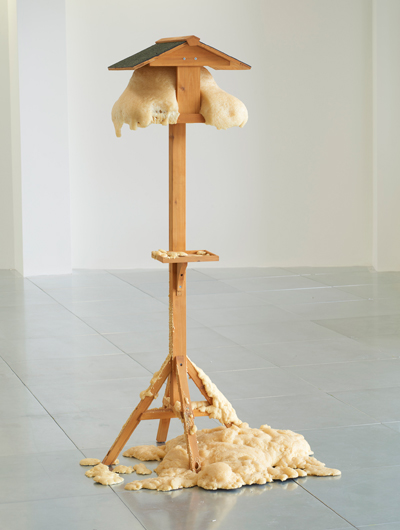|
An exhibition in Victoria is a thought-provoking exploration of the links between art and design in an incongruous setting The area surrounding Victoria station in London is undergoing a £2bn makeover of which one of the professed goals is to transform it into a “cultural district”. To that end, the owners of 1-5 Howick Place – one of many office buildings that have sprung up in the area recently – have temporarily given over five of its six floors to art consultancy HS Projects, which has curated two exhibitions for the 80,000sq ft space: Interchange Junctions, which ran earlier this year and explored the themes of migration, trade and colonial struggle, and Paradigm Store, which ends this week. The current show brings together new and recent work by 17 emerging and established artists that examines the blurred lines between art and design, decoration and function. The curators – Alistair Howick and Tina Sotiriadi – have taken full advantage of the vast space, spreading sculptures and installations sparsely across each floor with consideration of the architecture and consciousness of passers-by’s views into the building.
Claire Barclay’s Flat Peach On the ground floor, for example, Ulla von Brandenburg’s Segel – large bands of fabric in the colours of forests and the sky sewn together to form a striped sail-like whole – is draped so its entire length faces the building’s front window. On the other side of the floor, as part of art duo Cullinan Richards’ installation of found, crafted and manufactured objects, old movie lightboxes with the words “OOOO” and “Devine” face the street. One of the most playful pieces is Greek artist Theodoros Stamatogiannis’s 7m-long door that transforms the huge section of the room it is in as it swings on its hinge; his work considers the relative roles of function and aesthetics in architectural components. In the basement, Scottish artist Claire Barclay’s Unbound installation of peach silk pulled taut across a painted steel structure, is located in a high-ceilinged alcove that can be looked down upon from the street through the windows above. Another of her works, on the fourth floor – Fault on the Right Side – comprises a table with mirrors placed as if they are diners sitting around it, which reflect the activity in the office buildings across the road. The latter, previously displayed in a neoclassical building with an ornate chandelier hanging above it, appears marginally too tall for the room. Indeed, while the works themselves are striking, with the large spaces between them allowing room for contemplation, they sit somewhat uneasily in a building with an unavoidably corporate aesthetic. The low ceilings, fluorescent lighting and lifts operated by security pass are reminders that this is not a gallery, but an office.
David Shrigley’s Bird Table Some pieces are placed to complement each other rather than paying particular heed to the surroundings, such as Nike Savvas’ Sparks series, the bright digital colours of which echo those of Maria Nepomuceno’s vibrant, almost organic, sculptures of beads and rope that reference the craft traditions of her native Brazil. Other works explore global themes. Paula Roush’s Participatory Architecture, is a series of photos, documents and found objects relating to a now-threatened social housing development build in Portugal after the end of the Salazar dictatorship in the 1970s, when modernist architectural projects flourished. On the fourth floor, another work by Von Brandenburg, Singspiel, is a film set in Le Corbusier’s Villa Savoye on the outskirts of Paris, inspired by the building’s history, with actors playing out familial encounters. The work common to both Paradigm Store and the previous exhibition is Wind Sculpture, a permanent piece outside the building by Japanese artist Yinka Shonibare, commissioned by the building’s developers before Interchange Junctions began. The 6m-high sail-like structure is decorated with African batik print, in reference to colonialism, trade and racial politics and inspired by the area’s connection to Viscount Howick, who played a role in ending the transatlantic slave trade. A more subtle message is on the fifth floor: next to one of David Shrigley works – a bird’s house with expanding foam spilling out in macabre fashion – the words “environmental” and “sustainable” are emblazoned on the wall, suggesting that, for the property developers, commissioning a pop-up art exhibition was more about PR than culture.
Simon Bedwell’s Untitled (No Inside) This contrast between the works and the space they are displayed in unintentionally poses additional questions about the relationship between architecture and art. While the presence of work by Simon Bedwell – who, as part of art collective Bank, has previously critiqued the increasing commercialisation of art – is particularly incongruous in this context, Beatriz Olabarrieta has engaged with this conflict head-on, wryly incorporating materials reclaimed from the office’s marketing suite – a bar, a TV screen and shoes – into her installation. The exhibition ends on 5 November, after which other tenants will join sixth-floor occupant Armani to fulfill the building’s original purpose. Paradigm Store ends on 5 November |
Words Debika Ray
Images: Sylvain Deleu, HS Projects, Stephen Friedman Gallery, London |
|
|






















